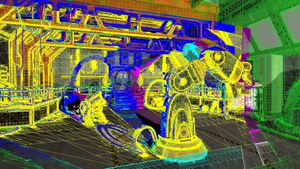Information
- Publication Type: Journal Paper with Conference Talk
- Workgroup(s)/Project(s): not specified
- Date: December 2022
- Journal: ACM Transactions on Graphics
- Volume: 41
- Number: 6
- Location: Daegu
- Lecturer: Jozef Hladky
- ISSN: 1557-7368
- Event: Siggraph Asia
- Call for Papers: Call for Paper
- Publisher: ASSOC COMPUTING MACHINERY
- Conference date: 6. December 2022 – 9. December 2022
- Keywords: streaming, real-time rendering, virtual reality
Abstract
Cloud rendering is attractive when targeting thin client devices such as phones or VR/AR headsets, or any situation where a high-end GPU is not available due to thermal or power constraints. However, it introduces the challenge of streaming rendered data over a network in a manner that is robust to latency and potential dropouts. Current approaches range from streaming transmitted video and correcting it on the client---which fails in the presence of disocclusion events---to solutions where the server sends geometry and all rendering is performed on the client. To balance the competing goals of disocclusion robustness and minimal client workload, we introduce QuadStream, a new streaming technique that reduces motion-to-photon latency by allowing clients to render novel views on the fly and is robust against disocclusions. Our key idea is to transmit an approximate geometric scene representation to the client which is independent of the source geometry and can render both the current view frame and nearby adjacent views. Motivated by traditional macroblock approaches to video codec design, we decompose the scene seen from positions in a view cell into a series of view-aligned quads from multiple views, or QuadProxies. By operating on a rasterized G-Buffer, our approach is independent of the representation used for the scene itself. Our technical contributions are an efficient parallel quad generation, merging, and packing strategy for proxy views that cover potential client movement in a scene; a packing and encoding strategy allowing masked quads with depth information to be transmitted as a frame coherent stream; and an efficient rendering approach that takes advantage of modern hardware capabilities to turn our QuadStream representation into complete novel views on thin clients. According to our experiments, our approach achieves superior quality compared both to streaming methods that rely on simple video data and to geometry-based streaming.Additional Files and Images
Weblinks
BibTeX
@article{hladky-2022-QS,
title = "QuadStream: A Quad-Based Scene Streaming Architecture for
Novel Viewpoint Reconstruction",
author = "Jozef Hladky and Michael Stengel and Nicholas Vining and
Bernhard Kerbl and Hans-Peter Seidel and Markus Steinberger",
year = "2022",
abstract = "Cloud rendering is attractive when targeting thin client
devices such as phones or VR/AR headsets, or any situation
where a high-end GPU is not available due to thermal or
power constraints. However, it introduces the challenge of
streaming rendered data over a network in a manner that is
robust to latency and potential dropouts. Current approaches
range from streaming transmitted video and correcting it on
the client---which fails in the presence of disocclusion
events---to solutions where the server sends geometry and
all rendering is performed on the client. To balance the
competing goals of disocclusion robustness and minimal
client workload, we introduce QuadStream, a new streaming
technique that reduces motion-to-photon latency by allowing
clients to render novel views on the fly and is robust
against disocclusions. Our key idea is to transmit an
approximate geometric scene representation to the client
which is independent of the source geometry and can render
both the current view frame and nearby adjacent views.
Motivated by traditional macroblock approaches to video
codec design, we decompose the scene seen from positions in
a view cell into a series of view-aligned quads from
multiple views, or QuadProxies. By operating on a rasterized
G-Buffer, our approach is independent of the representation
used for the scene itself. Our technical contributions are
an efficient parallel quad generation, merging, and packing
strategy for proxy views that cover potential client
movement in a scene; a packing and encoding strategy
allowing masked quads with depth information to be
transmitted as a frame coherent stream; and an efficient
rendering approach that takes advantage of modern hardware
capabilities to turn our QuadStream representation into
complete novel views on thin clients. According to our
experiments, our approach achieves superior quality compared
both to streaming methods that rely on simple video data and
to geometry-based streaming.",
month = dec,
journal = "ACM Transactions on Graphics",
volume = "41",
number = "6",
issn = "1557-7368",
publisher = "ASSOC COMPUTING MACHINERY",
keywords = "streaming, real-time rendering, virtual reality",
URL = "https://www.cg.tuwien.ac.at/research/publications/2022/hladky-2022-QS/",
}


